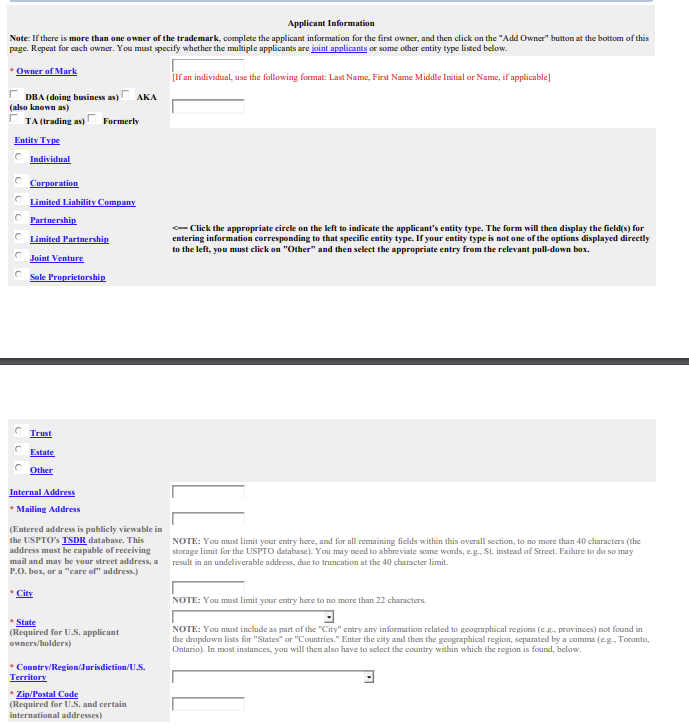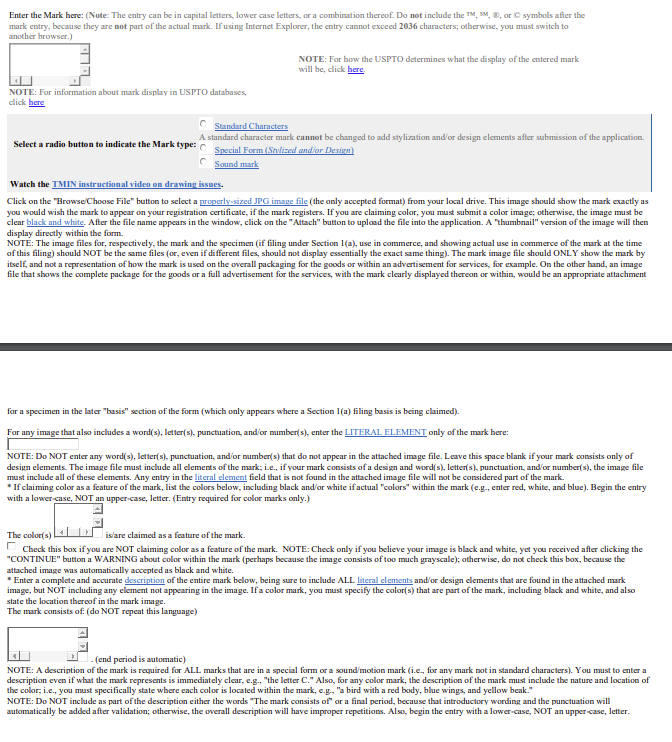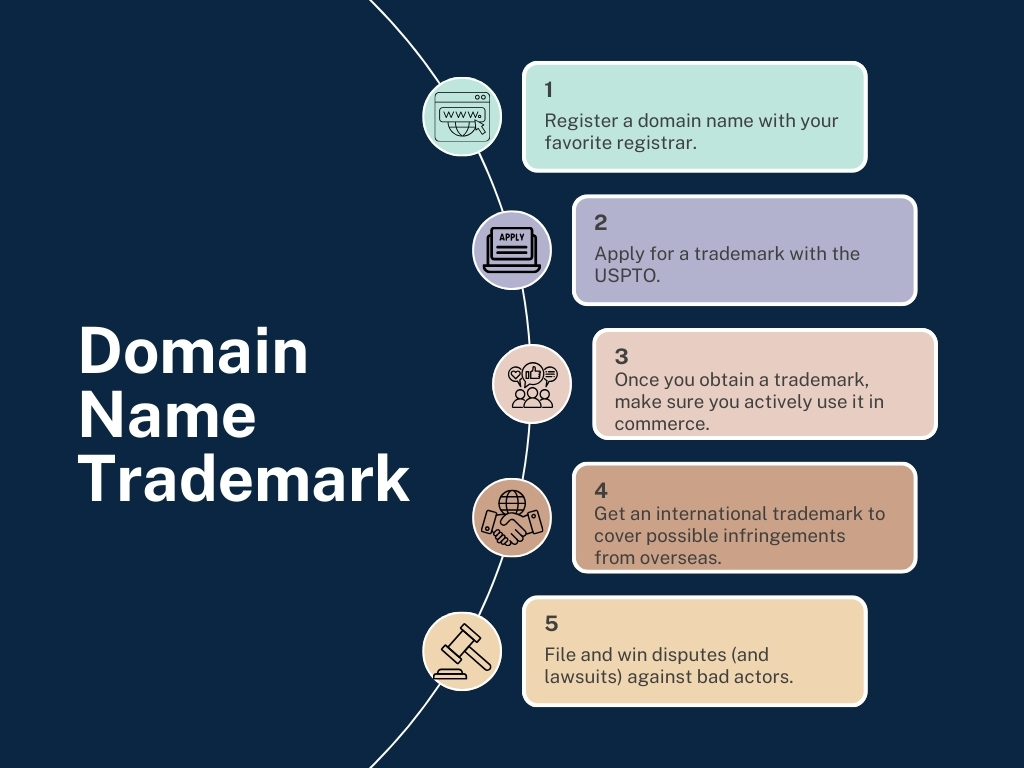Trademark a Domain Name: All You Need to Know
You can protect your online business and website as a provider of unique goods and services with a domain name trademark. Getting one is possible if the name is distinctive enough and you use it to sell specific products or services.
In this article, we’ll show you how to register your domain name as a trademark and protect it under U.S. law, when to do it, and why.
| Key Points |
|---|
| A domain name needs to be unique and in use to qualify for a trademark. |
| A domain name trademark helps you protect your brand from cybersquatting. |
| Having a trademark helps you handle disputes more effectively. |
When Does a Domain Name Qualify as a Trademark?
A trademark can be any term, symbol, phrase, logo, or design that makes your product or service unique and distinguishable from others. Note that the word trademark is used as an overarching term for both trademarks and service marks.
According to the United States Patent and Trademark Office (USPTO), the purpose of a trademark is to:
- Identify the source of goods or services,
- Offer legal protection for your business,
- Protect you against fraud and counterfeiting.
Now, that doesn’t mean that anything can become a trademark just for the sake of it. You can’t use a generic or descriptive trademark that doesn’t identify the product or service in any way. Non-registrable trademark examples include:
- Coffee shop,
- Bicycle store,
- Cold ice-cream,
- Hosting service.
Do I Need a Domain Name Trademark?
Having a domain name doesn’t automatically mean you can take out a trademark in its name. For a registered domain name to become a trademark, it needs to satisfy the following:
- The name must be distinctive, or consumers associate it with specific products or services.
- The current domain name owner is the first one to use the domain name for the sale of specific products or services.
- The domain name is used to sell the product/service. Showing a simple URL won’t be enough to convince the USPTO to register a trademark.
In other words, if you want to trademark your domain name, you need to have a unique name that’s specific, suggestive, or fanciful enough to be considered distinctive.
MORE: Learn about different types of domains
When choosing a domain name, try to come up with a unique and memorable name that will help you secure a trademark for your business. If you’re struggling to be creative with your names, use our AI-powered domain name generator to get 1,000+ unique name ideas instantly.
What About Companies With Generic Names?
The use of trademarks is limited to a geographical area and industry. Even if you take out a federal trademark, it only applies to the United States. Also, if you have a business making chopsticks and a trademark for the word ChopChop, that doesn’t mean that a woodcutter can’t use the same name for their company.
Another example is Apple technology. Apple is a generic word, but we recognize it as a brand, and they managed to secure a trademark within the IT industry. If Steve Jobs had been a greengrocer, he would have had to use a different name.
When it comes to domain names, there are some exceptions to the rules above, but they are rare. One famous example is Booking.com. Initially, the traveling agency filed for a domain name trademark, and the USPTO denied their request. The office claimed the word “booking” is too generic, and adding a top-level domain next to it doesn’t make them distinguishable enough.
However, the company appealed to a federal court, arguing that the term booking.com (with the extension) doesn’t signify any reservation service but is recognized as a specific brand. The federal court reversed the USPTO’s decision.
Unless you have the time and resources as Booking.com to go against the USPTO, we suggest you tow the trademarking line.
What is the Relationship Between Trademark and Domain Name?
Domain names don’t have a direct impact on trademarks. On its own, a domain name doesn’t create customer association, even if you use the same name for your domain and your company. You need to show that you use the domain name to sell your company’s products or services, which can lead to creating trademark rights.
On the other hand, once you have a domain name trademark, you can protect yourself from impostors and cybersquatters.
Let’s say that Starbucks.com was available. If you registered it, the coffeehouse would quickly sue you for trademark infringement, and you’d most likely have to hand over the rights to use the domain name.
This, of course, doesn’t apply if you registered the name before the trademark was issued, although you would have to prove that you didn’t do it in bad faith, e.g., for a reselling profit, impersonation, or customer diversion.
In other words, a domain name has no effect on a trademark, but a trademark can help you protect and obtain a domain name with your brand. While it’s not mandatory to have a trademark, it can be helpful.
Andrew Rapacke, an intellectual property attorney from The Rapacke Law Group, says that, due to the official domain name dispute policy (UDPR), a trademark can help you cancel, suspend, or obtain usage rights of an infringing domain. With a trademark, you have better chances of proving someone’s use of your brand in bad faith.
Steps to Register a Domain Name Trademark
The process of domain name trademark registration is the same as with any other type of trademark. The process slightly differs depending on where (in which country) you want to take out the trademark.
When it comes to getting a trademark in the United States, the first thing you need to do is search the USPTO database to see if there are any pre-existing trademarks with the same or similar words.
You want to avoid any likelihood of confusion, such as using synonyms, similar pronunciations, or a different spelling of the same word.
Once you’re sure your domain name is unique, you need to do the following:
- Prepare the application: You’ll need to provide personal details and contact information, the name you plan to trademark, the basis for filing, and the list of products and services the name covers. You should also prepare a registration fee that can go from $250 to $350 per class, plus potential legal fees.
- File the application with the USPTO: You can apply via the Trademark Electronic Application System (TEAS) or TEAS Plus. When you file your application correctly, you’ll receive a receipt and a serial number for future reference.
- Wait for the process to finish: During the review of the application, you may receive letters with any problems you need to resolve for your application to be accepted. If all is good, the USPTO will publish the trademark and wait for about three months for any opposition. If there is none, you will have a registered trademark.
If you want to file the application without a lawyer, you can find the necessary documents on the USPTO website.

Before you submit your application, make sure all the information is accurate and that it checks all of the boxes in terms of what the office requires. For example, you’ll need to provide the following:
- Mark type and name,
- Color of the mark (if applicable),
- Complete description of the entire mark,
- Translations and transliterations of the mark.

MORE: How to buy domain names
How to Manage Domain Name Disputes
When you have a registered domain name, you’re automatically subject to the UDRP, a dispute resolution policy. Under the policy, two parties need to handle the dispute by arbitration, agreement, or court action.
If someone has registered a domain name with your trademark (or a similar name) in bad faith, you can file a complaint with an accredited service provider or court. If you go down this road, you need to prove that the respondent has acted in bad faith, such as cybersquatting and business disruption.
You can also rely on the Anticybersquatting Consumer Protection Act (ACPA). To prove trademark infringement under the ACPA, you need to file a claim in federal court. While this is more expensive than seeking a resolution under the UDRP, you can use it to reverse a UDRP decision, receive monetary damages, and seek attorney’s fees from the defendant.
As a trademark owner, you have multiple avenues to take care of infringement disputes. If the above methods fail, you can send a cease and desist letter and file an infringement lawsuit.

Takeaway Points
Taking out a trademark can help you protect your domain name as an established brand of your company. With a trademark, you can more easily protect yourself and prove a domain name is infringing on your rights.
However, to get one, you need to prove you’re using the domain name as a distinguishable place for selling your products or services, and the name must be unique. You might be better off not having a trademark and using an industry keyword that will attract more customers to your website.
If you want to have a unique and memorable domain name, check out our domain name generator for free.